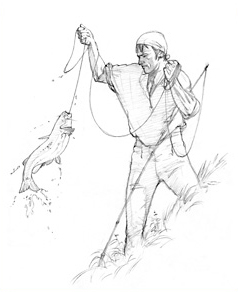Silas Goodrich was the expedition’s principal fisherman. He also did well when trading for food with Indians from time to time. He was a sometime hunter, but not among the expedition’s major ones.
Like Hugh McNeal, he visited Indian women and contracted syphilis among the Chinooks in 1806. Both men received the ineffective, mercury-based treatment of the day, dangerous in itself.[1]See details of the illness and treatment under Hugh McNeal. In 1807, Goodrich joined seven other Corps members in petitioning Congress that their land grants be situated in Indiana or Upper Louisiana (Missouri), where they already had settled—rather than west of the Mississippi.[2]On 3 March 1807, Congress passed an Act granting each of the enlisted men, including the sergeants, 320 acres “which . . . may be located . . . on any of the public lands of the United States, … Continue reading Goodrich may have married and fathered eight children,[3]Larry E. Morris, The Fate of the Corps: What Became of the Lewis and Clark Explorers After the Expedition (New Haven: Yale University Press, 2004), 194. but was dead by 1825–1828 when Clark jotted down the names of Corps members and whether they were living, had died, or had been “killed.”
[17 July 1804, Clark:] Gutrich caught two verry fat Cat fish
[24 July 1804, Clark:] This evening Guthrege Cought a white Catfish, its eyes Small & tale much like that of a Dolfin
[7 September 1804, Ordway:] a verry large cat fish caught. by Goodrich last night.
[5 June 1805, Ordway:] one man by the name of Goodrich has caught a considerably quantity of fish. Some of which are Shell fish, but the most part are Small cat fish. . . . as we have a great pleanty of meat we do not trouble ourselves for to catch fish.
[11 June 1805, Lewis:] Goodrich who is remarkably fond of fishing caught several douzen fish of two different species.
[12 June 1805, Lewis:] I amused myself catching those white fish mentioned yesterday . . . they bit most freely at the melt [spleen] of a deer which Goodrich had brought with him for the purpose of fishing.
[13 June 1805, Lewis:] Goodrich had caught half a douzen very fine trout and a number of both species of the white fish.
[20 August 1805, Lewis:] Goodrich caught several douzen fine trout today.
[24 August 1805, Lewis:] Goodrich who is our principal fisherman caught several fine trout.
Notes
| ↑1 | See details of the illness and treatment under Hugh McNeal. |
|---|---|
| ↑2 | On 3 March 1807, Congress passed an Act granting each of the enlisted men, including the sergeants, 320 acres “which . . . may be located . . . on any of the public lands of the United States, lying on the west side of the Mississippi.” Donald Jackson, ed., Letters of the Lewis and Clark Expedition with Related Documents, 1783-1854; 2nd ed.; 2 vols. (Chicago: University of Illinois Press, 1978), 2:377. |
| ↑3 | Larry E. Morris, The Fate of the Corps: What Became of the Lewis and Clark Explorers After the Expedition (New Haven: Yale University Press, 2004), 194. |
Experience the Lewis and Clark Trail
The Lewis and Clark Trail Experience—our sister site at lewisandclark.travel—connects the world to people and places on the Lewis and Clark Trail.
Discover More
- The Lewis and Clark Expedition: Day by Day by Gary E. Moulton (University of Nebraska Press, 2018). The story in prose, 14 May 1804–23 September 1806.
- The Lewis and Clark Journals: An American Epic of Discovery (abridged) by Gary E. Moulton (University of Nebraska Press, 2003). Selected journal excerpts, 14 May 1804–23 September 1806.
- The Lewis and Clark Journals. by Gary E. Moulton (University of Nebraska Press, 1983–2001). The complete story in 13 volumes.


